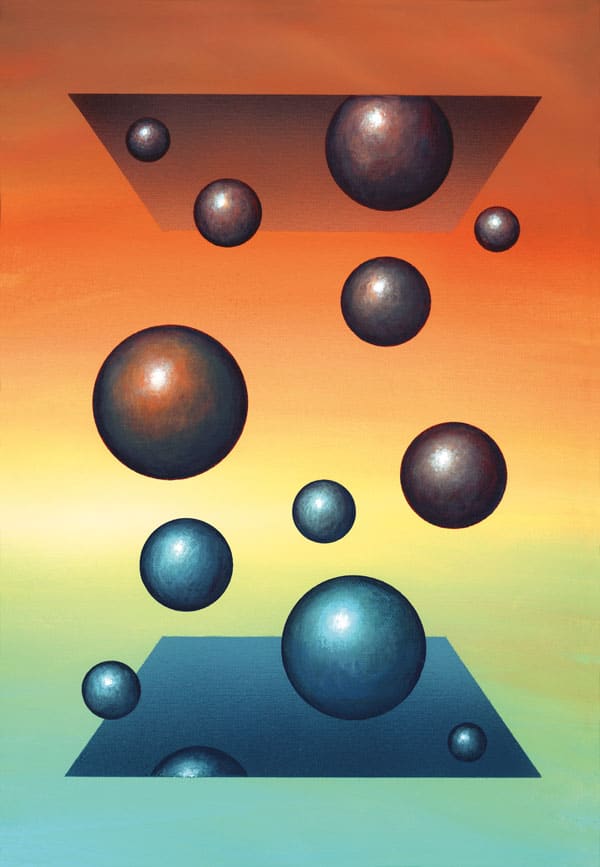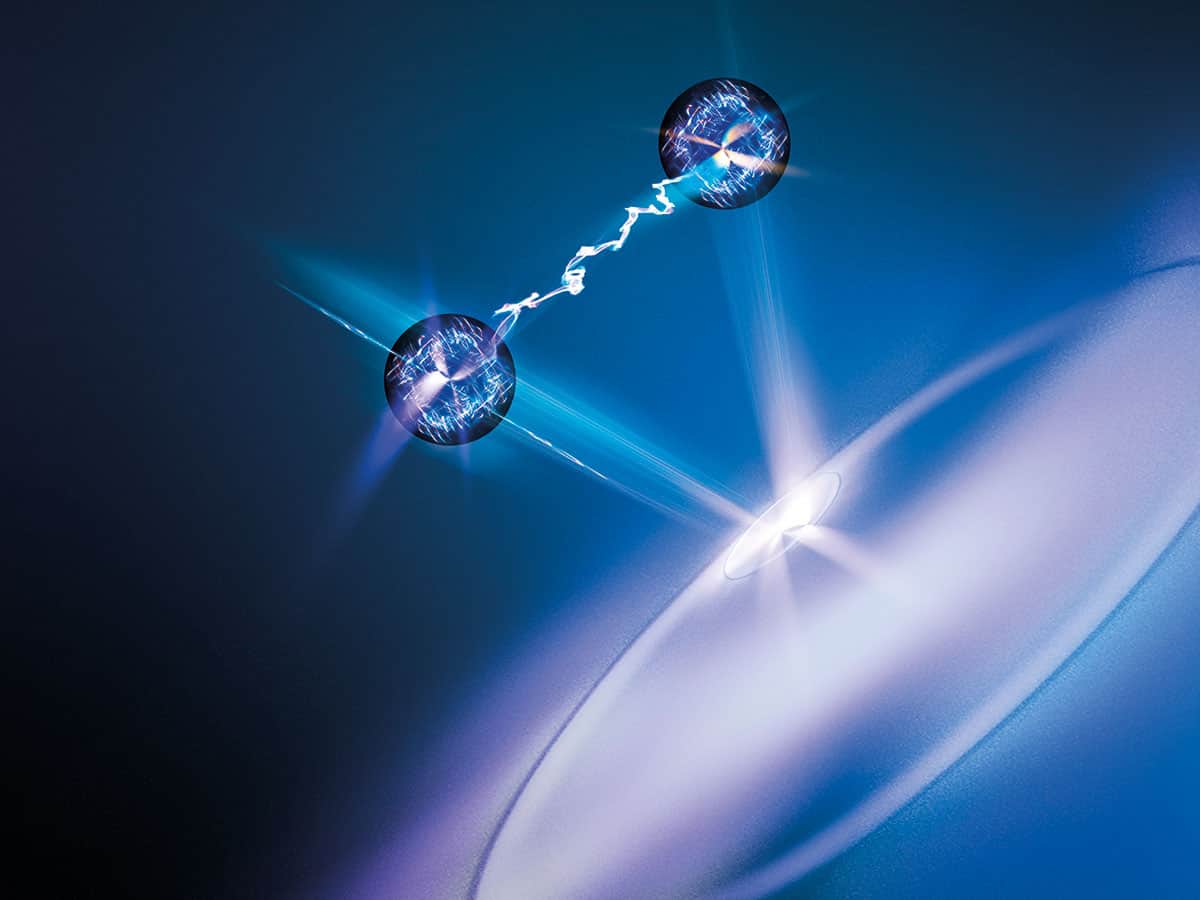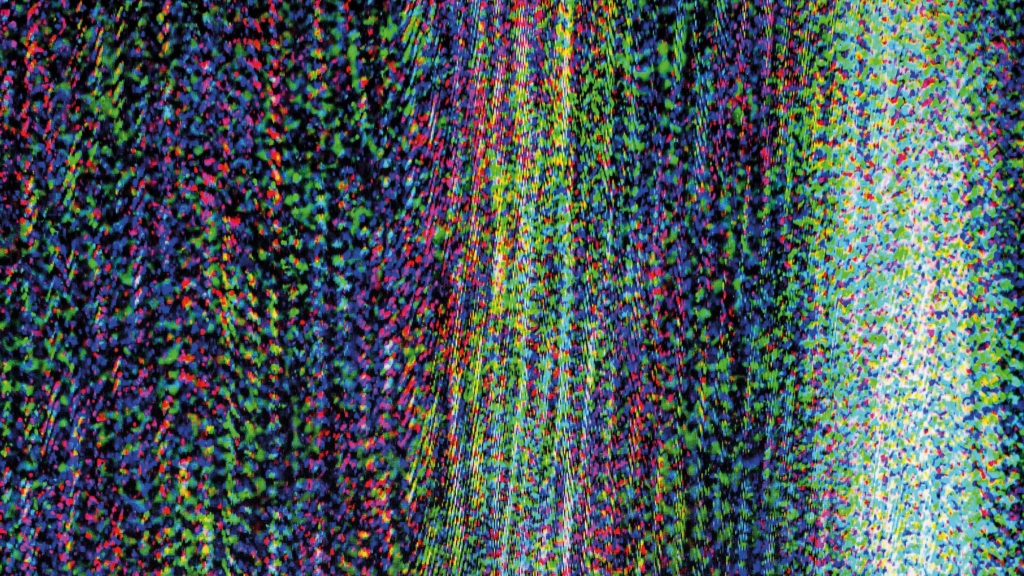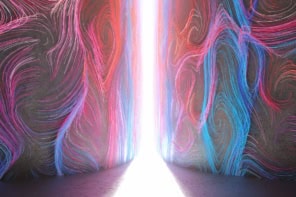Could noise in a quantum system be used to do work? Philip Ball looks at new research that’s attempting to make a feature of a fault, which may also link quantum mechanics to thermodynamics on a fundamental level
Noise doesn’t get good press, but physicists made their peace with it long ago. Typically, it’s seen as just a bit of random grit in the wheels: the low-level, unpredictable stuff that jiggles your experiment and which you can’t really know about. But there’s another sort of noise too, and it comes from quantum mechanics. Rather than being stuff you don’t know about, it is stuff that you fundamentally can’t know about: the randomness at the heart of quantum theory.
Ever since the random nature of quantum mechanics was first proposed by its pioneers in the 1920s, it has been controversial. Most famously, Albert Einstein went as far as to say that “God does not throw dice” to determine the outcome of measurements. Quantum noise continues to tantalize researchers today, as it seems to hold clues about what this perplexing theory is all about.
But some researchers think it does even more than that. They think quantum noise might act as a resource that can do work – if only we can learn how to tap into it. As well as suggesting intriguing practical opportunities for making strange new kinds of microscopic engines, quantum noise offers an alluring glimpse of deep connections within physical theory: between the quantum and classical worlds, between information and work, and between quantum theory and the statistical laws of thermodynamics.
Quantum noise might act as a resource that can do work – if only we can learn how to tap into it
Philip Ball
The random, noisy nature of the quantum world stems from the limits to our knowledge of it, as described by Werner Heisenberg’s uncertainty principle, formulated in 1927. This states that we cannot know, at the same time and with arbitrarily fine accuracy, all the properties of a quantum system. Certain of them – most famously, position and momentum – are so-called “conjugate variables”, meaning that they are linked by an uncertainty relation. The more precisely we know the position of a quantum particle, say, the less precisely we can know its momentum. The product of these two uncertainties is proportional to Planck’s constant h, the basic yardstick of quantum action, postulated in 1900 by Max Planck.
In formal terms, the uncertainty relation stems from the mathematics describing how we make predictions about outcomes of measurements on a quantum system. Any observable has a corresponding “operator”: a mathematical transformation applied to the wavefunction, that shows the possible values a measurement can elicit. During measurement, the operator is said to “project” one such value out of the wavefunction. Operators for conjugate variables – say, for position p and momentum q – are characterized by the fact that the outcomes of the operations pq and qp differ by an amount proportional to h. This property where pq and qp are non-equivalent is called non-commutation.
Wiggle room
It’s tempting to regard the uncertainty principle as a kind of fuzzy veil that obscures the real values of these variables. But that’s not the right way to see it. As far as we can tell, what it really means is that the variables are themselves defined no more precisely than Heisenberg’s limits allow. This gives the quantum world some wiggle room… and within that space, wiggle it does. So-called quantum fluctuations – the source of quantum noise – happen all the time. A well-known example is the tendency of particles and their corresponding antiparticles to pop in and out of existence in a vacuum, bringing it alive with a quantum hum.
These fluctuations can be regarded as the origin of physical, observable effects ranging from the Casimir force – which causes attraction between two closely spaced surfaces – to Hawking radiation, which is thought to stream from the event horizons of black holes. The fluctuations can drive low-temperature “quantum phase transitions” between different states of exotic materials dominated by quantum effects. This is similar to how classical fluctuations caused by heat underpin “critical” phase transitions such as the switch between ordered and disordered states of ferromagnets.
The difference is that you can reduce classical noise by lowering the temperature – at absolute zero it vanishes altogether – but you can’t get rid of quantum noise. The universe is always alive with it. “Classical noise is usually thought of as ‘lack of knowledge’, meaning that if we knew all the details (of every particle), there would be no noise, or heat,” says Vlatko Vedral, a quantum theorist at the University of Oxford, UK. “Quantum noise, on the other hand, is fundamental, in the sense that even a complete knowledge of the system would still leave us with some residual quantum uncertainty.”
Noise is generally regarded as an inconvenience – something apt to disrupt our ability to control systems precisely. For a long time, quantum noise was thought to be no different. It “has been known from the beginning of quantum physics”, says Vedral, and “was thought of as always being bad”. But that’s changing. “Now we think of it very differently and are asking how to harness it,” he says.
Working demon

How, though, do you get anything useful from random fluctuations? Well, there is already a scheme for doing that with classical noise, and it dates back to the 19th century. In a warm environment, there’s plenty of energy around. But if it’s uniformly spread, there seems to be no way to put it to use. That’s one way of looking at the second law of thermodynamics, which can be expressed as the notion that heat passes from hot to cold. Unless a temperature gradient exists, there’s no reservoir that can be tapped to do work.
But in 1867 James Clerk Maxwell used the new microscopic understanding of heat as random molecular motions to suggest a way of cheating the second law. He conjured up the image of a tiny being – later dubbed a demon – that can see individual molecules moving about in two chambers of gas. This demon selectively opens and shuts a trapdoor linking the two compartments, so as to let faster-moving, more energetic molecules congregate on one side, and slower ones on the other. This divides a gas of initially uniform average temperature into a hot and a cool side, thereby creating a temperature gradient that can then be used to do work of some kind. In that process, the entropy of the system decreases – it becomes less random and more structured, in contradiction of the second law’s insistence that total entropy must always increase in any process of change.
The key here is that the demon has access to information that we, at the macroscopic scale, lack: it knows the details of all the molecular motions. Information itself becomes a resource for doing work. The notion that there is an equivalence between information and energy has been demonstrated in recent experiments. For example, in 2010 physicists in Japan used precise observations of randomly moving particles in solution to increase their energy. In 2016 researchers at Aalto University in Finland built an autonomous microelectronic device that enables electrons to move against an “uphill” energy gradient (voltage) – thereby cooling the device – by sensing their motions and adjusting the voltage accordingly.
But Maxwell’s demon can’t in fact evade the second law, although the reasons for that were not fully understood until 100 years after Maxwell posed his thought experiment. The problem is that information about the particle motions can’t be accumulated forever, in the mind of a finite demon. In 1961 the physicist Rolf Landauer showed that there is an unavoidable entropic cost to erasing information, and this offsets any work that the demon is able to extract.
Quantum mine
Maxwell’s demon mines thermal noise (while ultimately respecting the second law). But is there an equivalent for quantum noise? At first glance, there’s a problem with that idea. Maxwell’s demon can use classical thermal fluctuations as a resource because it has access to the information that exists within them, albeit hidden from human eyes. But in quantum fluctuations there is no hidden information. It’s not that we don’t know about the “true” values of variables underlying the uncertainty, but that such a notion has no meaning.
In quantum fluctuations there is no hidden information. It’s not that we don’t know about the “true” values of variables underlying the uncertainty, but that such a notion has no meaning
Ah, but it can be given meaning: by measurement. That is how the probabilistic unknowns (or rather, unknowables) of a wavefunction collapse to particular values. So, in principle, quantum fluctuations can be turned into definite information by observation. But how can that be used to do work? It’s possible because, as several researchers have recently shown, a measurement of some quantum observable can increase the average energy of the system. This happens in specific cases, namely those where the quantum operator (which projects out of the wavefunction a value for the observable in question) does not commute with the energy operator of the system, known as the Hamiltonian – in other words, the observable and the energy are conjugate variables, like position and momentum.
In that case, the system’s “extra” energy comes from the measurement apparatus itself. Just as in the classical case, measurement reduces entropy and creates a source of energy that “can be transformed into work by an engine”, explains Juan Parrondo of the Universidad Complutense in Madrid, Spain. But whereas for the classical Maxwell’s demon it’s the “heat bath” of the surrounding environment that is mined to produce this work, in the quantum case there’s no actual heat bath – just the energy reservoir of the measuring apparatus, which becomes coupled to the quantum system by the very act of measurement. “You can look at the measurement as a battery that delivers energy in a random (noise-like) way,” says Peter Talkner of the University of Augsburg in Germany. At root this is a consequence of the uncertainty relation between time and energy. During the finite interaction time of the quantum system and measuring apparatus (when the measurement is made), there is some quantum noise in the energy that lets it leak into the system.
Hot bit
This principle can be used to draw energy into a quantum system by making measurements on it. The idea is that the quantum system – a simple quantum bit, say, which can exist in two states – is coupled to some system on which it can perform work. The qubit is prepared in a superposition of states, and by then making a measurement of its state you can increase its average energy. You could say that it seems to get “hotter”. That heat can then be tapped to carry out work: it’s a “quantum engine”. In 2011 Talkner, working with Juyeon Yi, showed that, in theory, repeated measurements of the position of a single quantum particle can eventually drive it into a state corresponding to “infinite temperature”, which means that the system occupies all its energy states with equal probability.
Several researchers have proposed types of quantum engines that run by using measurement to tap into this quantum noise. Unlike classical heat-engines, such devices don’t need a heat bath or temperature gradient from which they draw their power. Once the measurement has been conducted, a feedback signal can reset the qubit to its initial superposition at no energy cost – but just as in the classical system, to fully close the cycle, the outcome of the measurement must be erased: the measuring apparatus is reset without looking at the result it measured. That has an entropic cost, and so no energy is being obtained free – the second law is still respected.
Alexia Auffèves at CNRS’s Institut Néel in Grenoble and colleagues have proposed how to make such a device, using a superconducting circuit, rather like those used for qubits in several prototype quantum computers. The output of this “quantum engine” would be photons that can be used to do something useful, like switch an optical device (Phys Rev. Lett. 118 260603). Talkner and Yi have described a quantum engine without the feedback step, which plays the role of resetting the memory for a classical Maxwell demon (Phys. Rev. E 96 022108). In that case there’s still no free lunch: the second law is protected because of entropy generated when the engine is reset for the next cycle. That’s done by letting it come into equilibrium with a thermal bath at a constant temperature, which washes away any information about the measurement.
Physical fundamentals
Looking at quantum fluctuations in the light of Maxwell’s demon doesn’t just raise the prospect of exploiting it to our benefit. It also suggests a way of linking these fundamental quantum phenomena to the discipline of thermodynamics. Auffèves believes that quantum fluctuations should be seen a source of noise intrinsically different from the randomness injected classically into a physical system by heat. But where, really, does that noise come from? It’s all very well to put it down to the non-commutation of quantum operators – but that’s an abstract mathematical thing that doesn’t offer much physical insight. Can we provide an intuitive explanation for quantum randomness?

That question goes to the heart of quantum theory. The wave equation proposed in 1924 by Erwin Schrödinger to describe quantum “particle waves” provides us with a wavefunction from which all observable properties of a quantum system can be predicted. The Schrödinger equation doesn’t predict outcomes in the way that Newtonian mechanics does for classical systems; rather, the wavefunction supplies the probabilities for what we might observe. In general, we can’t know for sure what value we’ll measure until we look. There’s apparently a fundamental randomness to quantum mechanics, which was what troubled Einstein so deeply about the theory.
A big unresolved question in the foundations of quantum theory is whether this inability to make exact predictions is truly fundamental, or just due to our lack of knowledge about some “real state of affairs”. The latter situation is comparable to the way we must treat classical noise as random because we can’t see all the molecules. The former, though, denies that there is any underlying “real state of affairs” at all.
Regardless of the exact origin of quantum randomness, we can understand why it has to be present. In 1935, while working at Princeton, Einstein and two younger colleagues, Boris Podolsky and Nathan Rosen, developed a thought experiment that they said cast doubt on the “completeness” of quantum mechanics, supporting the idea that the apparent randomness was just the result of our inability to access a true underlying state of affairs in which every variable had a definite, fixed value, albeit hidden from direct observation. This “EPR” experiment seemed to imply that, if quantum mechanics was all there is, particles would have to be able to influence each other instantly across space – an option precluded by Einstein’s theory of special relativity, which forbids any causative influence to travel faster than light.
Thanks to the work of Northern Irish physicist John Bell in the 1960s, we now know from experiments that Einstein’s “hidden variables” almost certainly don’t exist. But instantaneous “action at a distance” doesn’t exist either: it turns out that quantum randomness protects the universe against violations of faster-than-light communication – and thus rescues causality.
Context is key
That still doesn’t tell us where the randomness comes from, though. Auffèves and her colleague Philippe Grangier, of the University of Paris Saclay, have recently proposed a way of looking at quantum theory that they think might explain it – by starting with the long-known fact that the outcomes of quantum measurements depend on the context of the measurement. This was another of Bell’s profound insights in the 1960s, although this so-called quantum contextuality is more often ascribed to the mathematicians Simon Kochen and Ernst Specker, who derived the result at much the same time and published it before Bell in 1967. The Kochen–Specker theorem – which has been borne out by experiments in the past two decades – says that for quantum systems in general, it is meaningless to ask “What value does the variable x have?” Instead we must ask “What value does x have when measured in context y?” If we made the measurement differently from y, we might find a different value for x, without any theoretical inconsistency.

Auffèves and Grangier say that a quantum state – defined by a wavefunction, and amenable to experimental interrogation – can be defined only in a given context. That contrasts with classical systems, where a state – how fast a ball is travelling, say – doesn’t depend on the context of asking. The researchers call the possible outcomes of a measurement of some property of a system, made in a particular context, “modalities”. These are mutually exclusive: if you observe one of them, you can’t observe another too. There’s a fixed number of modalities for any system: say, if a photon hits a half-mirrored beam splitter, it can only be reflected or transmitted, and nothing else. This existence of discrete and exclusive modalities is what characterizes quantum systems, they say.
In this scheme, there’s nothing indeterminate or probabilistic about the quantum states themselves – they are perfectly objective, echoing Einstein’s conception of physical reality. “Instead of starting with probabilities, we start à la Einstein with certainties,” says Auffèves. But the crucial difference is that the quantum states don’t refer directly to the underlying system, but to the system and context as a whole. “While systems and contexts exist on their own and are ultimately made of the same stuff,” says Auffèves, “only together can they give rise to states, which correspond to definite, repeatable phenomena.” It’s only an old habit that we have from the classical world, she says, to think that systems alone should have states.
In this view, the probabilities characteristic of quantum mechanics aren’t then intrinsic to the quantum state, but arise in our efforts to make predictions about it. Only when we make an observation on the system – which demands a particular context – do we realize one of the possible modalities for sure. Quantum mechanics is then not a theory of the fundamental systems in themselves, but a formalism for dealing with the modalities that arise from them. The two researchers call this the Contexts-Systems-Modalities (CSM) approach (Phil. Trans. A 10.1098/rsta.2017.0322).
Auffèves and Grangier show that, given these axioms, their approach produces all the characteristic features of quantum mechanics, such as superpositions and the Born rule for calculation probabilities. But here’s the catch. A system has a fixed number of modalities, but there are more contexts we could apply for measurement than those modalities can satisfy. In other words, there are more possible questions we can ask of a quantum system than there are certain, repeatable answers it can give. You could say that the definite modalities get “used up”, such that any additional modalities – the outcomes of probing the system further – are then delivered at random. It’s this randomness that is experienced as quantum noise.
Finite information
This view of quantum mechanics is still very speculative, but the basic idea echoes others that have been suggested previously. In 1999, for example, quantum physicist Anton Zeilinger at the University of Vienna suggested that a possible fundamental axiom of quantum theory is that all the fundamental entities (whatever they may be) can encode at most one bit of information (Found. Phys. 29 631). In other words, they can supply a definite answer to just a single yes/no question.
Zeilinger and his colleague Časlav Brukner have explained how this condition could lead to distinctly quantum behaviours, such as the results seen in EPR measurements where two entangled particles have correlated properties even though the values of those properties appear to be undefined before measurement. In essence, imposing the condition of correlation uses up all the possible “information-bearing” capacity of the two particles, so that the actual values of their individual variables (spin, say) have to be random. “Essentially, the main idea is that quantum system cannot answer incompatible questions because it has limited information content,” says Borivoje Dakić of the University of Vienna. “Thus, quantum randomness naturally shows up when we ask the system a question to which it lacks the capacity for an answer.”
That idea has been developed by Brukner, Zeilinger, Dakić (arXiv:0911.0695) and others (arXiv:1511.01130) to give full-blown “reconstructions” of quantum theory based only on simple axioms about how information is encoded in and shared between quantum particles. This quantum reconstruction is closely similar to the CSM approach, says Dakić.
Quantum mechanics defies causal order, experiment confirms
Auffèves agrees that there are clear parallels. “I am pretty sure that we can compare our maths and fruitfully inspire each other,” she says, “but the original dressing and the philosophical choice are different.” Dakić admits, though, that there’s not yet any firm justification for assuming that an inability to supply a deterministic answer must lead to a random one. “Why the system then answers in a probabilistic way is not clear to me,” he says. “I could imagine that the system simply remains silent, or could provide some uncertain answer. I think the question remains open.”
The existence of quantum randomness and noise seems, then, to be allied somehow to the issue of how information can be carried and distributed in quantum entities. But unlike the classical Maxwell’s demon, information here is not a question of how closely we can look at a system. Rather, it depends on how we decide to look. It’s as if information exists as a resource that we, by our choice of how to measure, can choose to channel into one property or another.
It’s as if information exists as a resource that we, by our choice of how to measure, can choose to channel into one property or another
Philip Ball
And that’s why quantum mechanics is still, a century after it was conceived, making us scratch our heads. It looks as if our intervention somehow calls the elements of reality into being – not in some vague “quantum woo” manner, but in a way that is rule-bound and quantifiable. Whether the CSM of Auffèves and Grangier supplies the right way of thinking about that conundrum remains to be seen. But perhaps the truth is that we need many ways of looking at this strange theory before we can start to discern its real shape.




